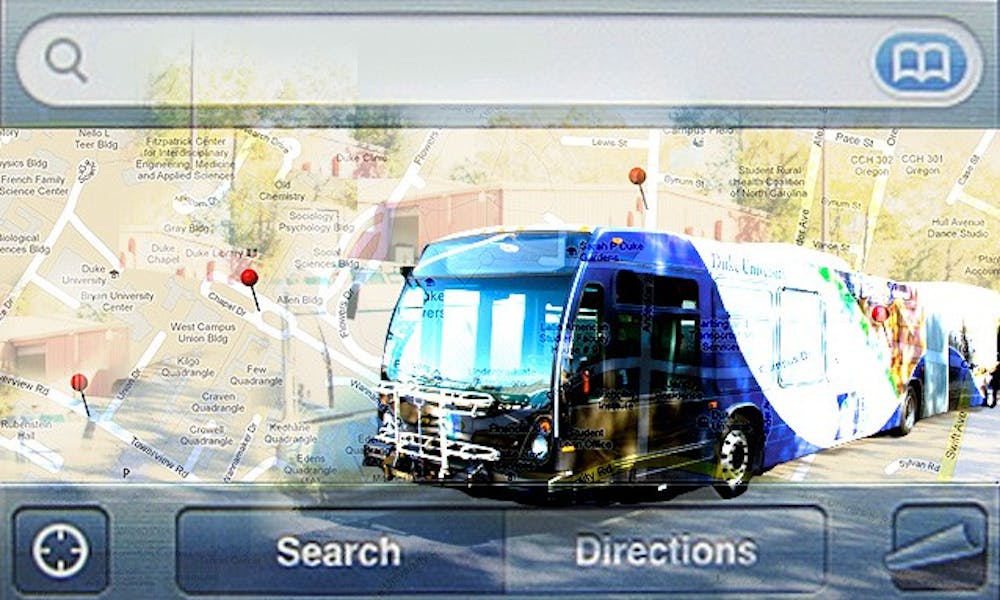Duke students will now have some assistance when facing the common dilemma of whether to take the C-1 or wait for a C-2.
All of the University’s buses have been outfitted with a new GPS tracking system that allows any student to view the real-time location of each bus in the fleet either on a web site or through a mobile application. The system is called TransLoc and is being made possible through a collaboration between Duke Student Government, Parking and Transportation Services and the Office of Information Technology. TransLoc will go live at the end of the month.
“We have a sampling rate of about a second, so you’ll see visibly and clearly where a bus is at any moment in time,” said Sam Veraldi, director of Parking and Transportation Services.
One important feature of TransLoc is that users will be able to see when the next bus will be arriving at a specific stop, reducing the stress of relying on a sometimes unpredictable bus system, he added. Users will also be able to receive notices of bus locations via text message.
“People have very busy lives, and we’ve all got many things that demand attention, so the ability to know when you’re at a location that a bus is really going to hit that location in three minutes... is going to give everyone a high degree of comfort,” Veraldi said.
The TransLoc system will also allow the posting of messages to notify students about delays and other changes to bus routes. In addition, the system will also contain tracking information on other area transit systems, such as the Bull City Connector and the Durham Area Transit Authority buses, Veraldi said.
DSG leaders have been working with Parking and Transportation Services to implement a bus tracking system since 2008. An attempt by several Pratt School of Engineering students to develop such a program in Fall 2010 ultimately failed, leading Parking and Transportation Services to look elsewhere, eventually selecting Raleigh-based technology company TransLoc to create the GPS system, according to a DSG press release Monday.
“We looked at a number of different existing products that were proven technologies, and [TransLoc] really rose to the top of the heap,” said Kyle Cavanaugh, vice president for administration.
Veraldi added that Parking and Transportation Services conducted interviews and demonstrations with about seven different companies before deciding on TransLoc.
The idea of a GPS tracking system for Duke buses is well-received among students.
Freshman Crystal Owens said the system will reduce the time she spends waiting for buses.
“[The buses] are not always quite on schedule, so I’d like to know where they are,” sophomore Eliza Gentzler added.
TransLoc is not the only new addition to transportation at Duke. Automatic passenger counters are also being installed on Duke buses. This technology will provide Parking and Transportation Services with data that can be used to increase the efficiency of Duke’s transit system, Cavanaugh said.
“What this... allows us to do is really manage the transportation component in a much more sophisticated way,” he said. “We’ll be able to look at parameters for benchmarking the routes and ridership and look at the total duration of time for not only the whole routes but also in between stops. It gives us lots of tools and gives the drivers lots of tools.”
Parking and Transportation Services also added eight new buses to the fleet at the start of the Spring, bringing the total number of buses in the University’s fleet to 28. The addition of the new buses, in conjunction with the elimination of some old buses, reduced the average age of the Duke bus fleet from more than 11 years down to six years, Veraldi said, noting that this will also reduce expenses.
The purchase of the new buses was the result of a lobbying effort by Duke Student Government that began in 2010. DSG President Pete Schork, a senior, said the organization was concerned about Duke’s aging buses.
“There have been several spontaneous fires over the past few years that really were concerning,” Schork said. “[The new buses] are also more reliable, so there’s fewer breakdowns and dependability for students is greater.”
Get The Chronicle straight to your inbox
Sign up for our weekly newsletter. Cancel at any time.

